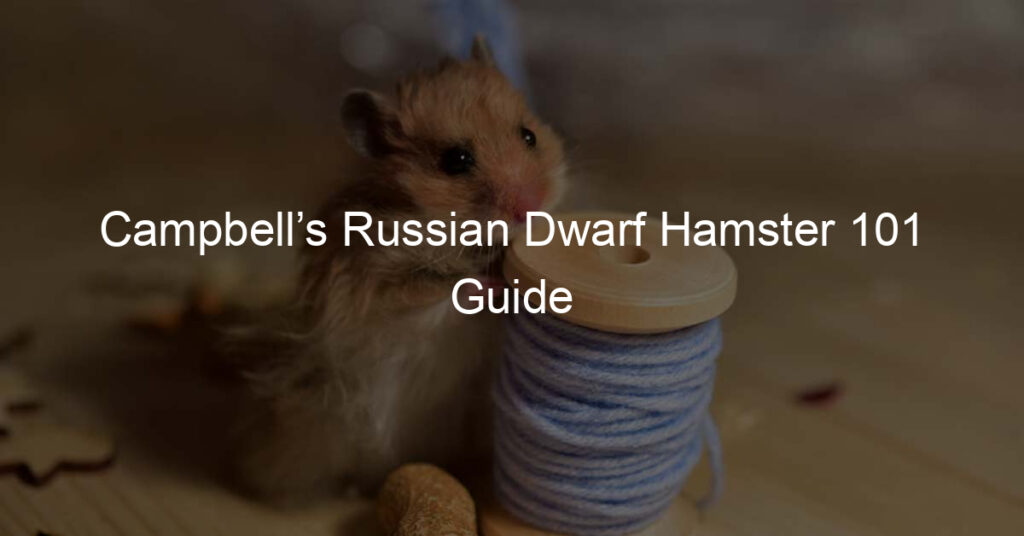Hey there! If you’re looking for some tips on how to take care of a Campbell’s Dwarf Russian hamster, you’ve come to the right place. In this blog post, we’ll go over everything you need to know about these cute little creatures, from what they like to eat and drink, to how often they should be exercised.
So whether you’re a first-time pet owner or a seasoned pro, this guide will help you ensure that your furry friend is healthy and happy. Let’s get started!
1. Campbell’s Dwarf hamsters are the smallest type of hamster, making them perfect for small homes or apartments.
2. They are very active and playful, so you’ll need to provide them with plenty of toys and space to run around.
3. These hamsters are known for being friendly and social, so they make great pets for families with children.
4. As with any pet, it’s important to do your research before bringing one home to make sure they’re a good fit for your lifestyle.
How do you take care of a Russian dwarf hamster?
Taking care of a Russian dwarf hamster is a fun, rewarding experience! The most important thing to keep in mind is that your pet needs an environment with plenty of stimulation to stay happy and healthy. Make sure their home is made out of a strong material like glass or plastic, and isn’t too small – they need enough room to run around and explore. Additionally, no matter which type of bedding you choose, it must be completely edible as they may try to eat it!
Your hamster will also need plenty of exercises – buy some tunnels for them to run through or set up some obstacles for them to climb. Furthermore, give them toys and treats to help keep their minds stimulated and let them explore; just be sure that anything you give them doesn’t have any toxins in it. Lastly, always ensure that the pair’s cage is cleaned regularly and make sure your furry companion has fresh water available at all times – don’t let dehydration happen! Taking these steps can assure you that your Russian dwarf hamster will remain a happy, healthy pet for years (or as long as they live!).
Are Campbell’s dwarf hamsters friendly?
Campbell’s dwarf hamsters are incredibly popular pets because of their size, but also because they’re friendly, making them suitable even for first-time owners. These small critters have a sweet and trusting nature, quickly becoming acclimated to human touch and handling. They enjoy being held and cuddled with hugs and kisses from their human companions and rarely bite or nip.
Campbell’s dwarves can make great little performers, happily running in wheels and mazes for treats. They can also be taught to play fetch in the same way as a dog – so these friendly animals provide lots of fun and entertainment. If you’re looking for an affectionate friend that you can trust, choose a Campbell’s dwarf hamster!
What do Campbell’s Russian dwarf hamsters eat?
Campbell’s Russian dwarf hamsters, also known as winter white hamsters, are popular exotic pets due to their playful demeanor and ease of care. To keep these little critters at their healthiest, it’s important to give them a well-rounded diet. Thankfully, Campbell’s Russian dwarf hamsters are omnivores and can eat a combination of grains, vegetables, fruits, and insects. Asa basic guide for nutrition, owners should go as close to the wild diet as possible and add in rat food or commercial pellets to provide a balanced diet.
If you’re concerned about feeding your hamster correctly, it’s best to consult your vet for appropriate amounts and food types for your particular rodent pals. All in all, with the right care and attention Campbell’s Russian Dwarf Hamsters can have an enjoyable life!
How long do Campbell hamsters live?
Campbell’s hamsters, also known as Djungarian hamsters, are an interesting breed of furry critters. Not only are they small and social, but these mice also have a relatively long lifespan too! In captivity, Campbell’s hamsters reportedly live around two to three years on average with the optimal care they need.
However, even if they don’t get the best home environment and attention, their survival rate is still impressively higher than expected – Campbell’s hamsters can actually live up to four years in certain conditions. Though short-lived like most other rodents, it’s pretty remarkable that these cute little creatures last longer than we think they do!
What do Russian Dwarf hamsters need in their cage?
Russian Dwarf hamsters are fun, low-maintenance pets that will bring plenty of joy to your home. In order to keep them healthy and happy, they need a spacious cage that is secure and easy to clean. It’s essential that the cage contains lots of toys and activities for your hamster to play with, and an exercise wheel lets them get the exercise they need.
Additionally, it should have plenty of bedding like wood shavings that are safe for your pet as well as food and water dishes. Russian Dwarf hamsters also require empty toilet paper rolls or tubes as hiding places; in nature, this would replicate their natural burrowing tendencies. With all these items in place, you’ll be able to give your Russian Dwarf hamster a happy home!
The Summary!
In conclusion, Campbell’s Russian Dwarf hamsters are a great choice for a pet as they provide lively and endearing companionship. They are gentle, sociable and intelligent animals that should be kept in an environment providing adequate pampering. With proper care, they can live up to 3 years, during which time they need fresh water and food daily, along with consistent cage cleaning.
A wide variety of toys and activities can also go a long way in keeping your Campbell hamster happy. As long as their needs are met, Campbell’s Russian Dwarf Hamsters make delightful companions that bring much joy to the lives of their owners.








